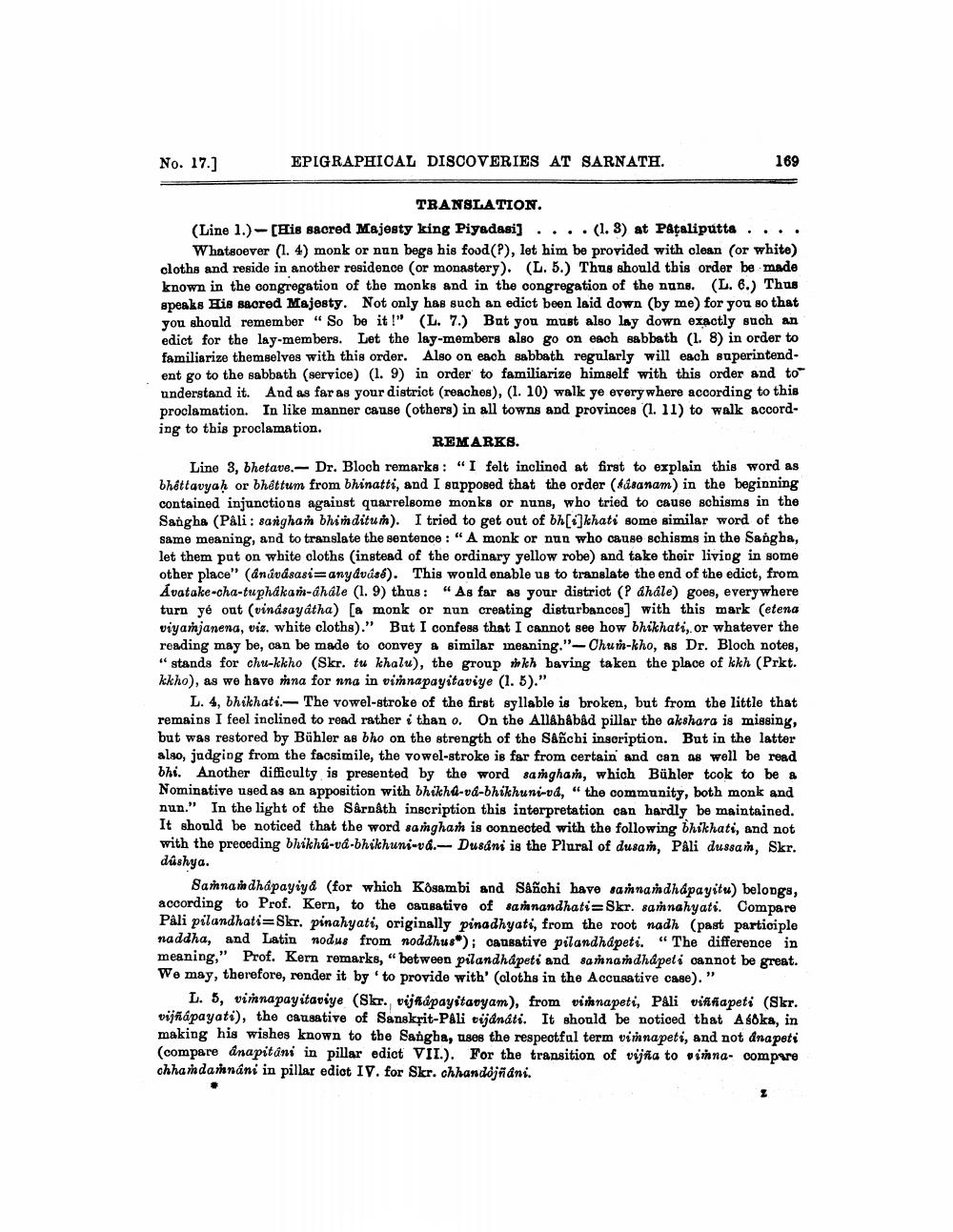________________
No. 17.]
EPIGRAPHICAL DISCOVERIES AT SARNATH.
169
TRANSLATION. (Line 1.)-[His sacred Majesty king Piyadasi] .... (1.3) at Pataliputta....
Whatsoever (1. 4) monk or nun begs his food(?), let him be provided with clean (or white) cloths and reside in another residence (or monastery). (L. 5.) Thus should this order be made known in the congregation of the monks and in the congregation of the nuns. (L. 6.) Thus speaks His sacred Majesty. Not only has such an edict been laid down (by me) for you so that you should remember “So be it!" (L. 7.) Bat you must also lay down exactly such an edict for the lay-members. Let the lay-members also go on each sabbath (1. 8) in order to familiarize themselves with this order. Also on each sabbath regularly will each superintendent go to the sabbath (service) (1.9) in order to familiarize himself with this order and to understand it. And as far as your district (reaches), (1. 10) walk ye everywhere according to this proclamation. In like manner cause (others) in all towns and provinces (1.11) to walk according to this proclamation.
REMARKS. Line 3. bhetave.- Dr. Bloch remarks: “I felt inclined at first to explain this word as bhéttavyaḥ or bhéttum from bhinatti, and I supposed that the order (Adsanam) in the beginning contained injunctions against quarrelsome monks or nuns, who tried to cause schisms in the Sangha (Pali: sanghan bhinditui). I tried to get out of bh[i]khati some similar word of the same meaning, and to translate the sentence: "A monk or nun who cause schisms in the Sangha, let them put on white cloths (instead of the ordinary yellow robe) and take their living in some other place" (anúvásasi=any dvasé). This would enable us to translate the end of the edict, from Avatake-cha-tuphakan-dhale (1. 9) thus: "As far as your district (? áhâle) goes, everywhere turn yé ont (vinasayatha) [a monk or nun creating disturbances] with this mark (etena viyamjanena, viz. white cloths)." But I confess that I cannot see how bhikhati, or whatever the reading may be, can be made to convey a similar meaning."-Chuth-kho, as Dr. Bloch notes, "stands for chu-kkho (Skr. tu khalu), the group ikh baving taken the place of kkh (Prkt. kkho), as we have nna for nna in viina payitaviye (1. 5)."
L. 4, bhikhati.- The vowel-stroke of the first syllable is broken, but from the little that remains I feel inclined to read rather i than o. On the Allahabad pillar the akshara is missing, but was restored by Bühler as bho on the strength of the SAñchi inscription. But in the latter also, judging from the facsimile, the vowel-stroke is far from certain and can as well be read bhi. Another difficulty is presented by the word sanghan, which Bühler took to be a Nominative used as an apposition with bhikhd-va-bhikhuni-vd," the community, both monk and nun." In the light of the Sárnáth inscription this interpretation can hardly be maintained. It should be noticed that the word saghan is connected with the following bhikhati, and not with the preceding bhikhú-va-bhikhuni-va. Dusdni is the Plural of dusan, Pali dussa, Skr. dúshya.
Samnandhapayiya (for which Kosambi and Sañohi have sannandhápayitu) belongs, according to Prof. Kern, to the causative of sannandhati=Skr. samnahyati. Compare Pali pilandhati=Skr. pinahyati, originally pinadhyati, from the root nadh (past participle naddha, and Latin nodus from noddhus*); cansative pilandhápeti. "The difference in meaning," Prof. Kern remarks," between pilandhápeti and sannandhåpeti cannot be great. We may, therefore, ronder it by to provide with' (cloths in the Accusative case)."
L. 5, vinnapayitaviye (Skr. vijnápayitavyam), from vinnapeti, Pali viftfiapeti (Skr. vijñápayati), the causative of Sanskrit-Pali vijanati. It should be noticed that Asoka, in making his wishes known to the Sangha, uses the respectful term vinnapeti, and not dnapets (compare anapitáni in pillar edict VII.). For the transition of vijna to oinna- compare chhandannani in pillar edict IV. for Skr. chhandojñiani.




